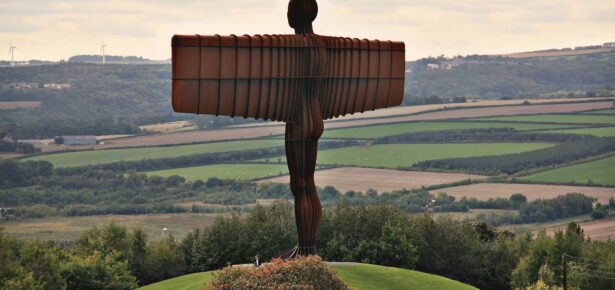
At Gateshead, along the A1 south of Newcastle, a 20-meter-high colossus stares out over the landscape. While some passersby have referred to it as the “Gateshead Flasher,” for its outstretched arms and wings, the 200-ton steel statue is actually the Angel of the North. Artist Antony Gormley’s creation is magnificent for many reasons, but I find it remarkable for the very fact that it evokes a biblical typology associated with the concept of North. Isaiah 14 envisions the rebellious angel Lucifer taking up his seat in a biblical North, and the association is deployed by medieval poets such as William Langland in the C-text of Piers Plowman and Geoffrey Chaucer in the Canterbury Tales to poke fun at the North of England. Augustine of Hippo’s exegesis of Isaiah 14, however, explains that, if the North has been occupied by Lucifer in the moment, then it will be remade in Christ’s triumphant return. Indeed, Langland quotes Augustine’s commentary directly, and it is this uncanny disposition of the North as both damning and salvific, both the seat of Hellish revolt and messianic redemption, that befits the political and religious character of the region in the literature of the Middle Ages. As a region under chronic rebellion while, at the same time, the frontline of defense against the enemy Scots, the North provokes a sense of the uncanny–both familiar and frighteningly unfamiliar at the same time.
While the English North-South divide is often associated with the Industrial Revolution, with Victorian novels such as Elizabeth Gaskell’s North and South, and even with regional economic disparities in the twenty-first century, this cultural rift was a significant medieval phenomenon that shaped, and was shaped by, the literature of the era. Writing the North of England in the Middle Ages offers a literary history of the North-South divide, exploring the complexities of regionalism and nationalism across a period that continues to inform English identity today. Its chapters examine some of the most popular literary examples of northern consciousness in the Middle Ages. When a student encounters medieval dialects in a course on the history of English, she will inevitably hear about Chaucer’s use of northern dialect in The Reeve’s Tale or the lowly shepherd’s comment to Mak the sheep-stealer in the Towneley Second Shepherd’s Play, that he should “take out that southern tooth and insert a turd.” In another oft-cited passage, the late-fourteenth century translator John Trevisa frames these examples with his complaint that “all the language of the Northumbrians, especially at York, is so grating to the ears that we southern men can hardly understand it.” And, of course, this is just the English translation of a gripe lodged, in Latin, four decades earlier by the Cheshire monk Ranulph Higden, who is, himself, repeating the derision of northern English voiced by the twelfth-century Wiltshire monk William of Malmesbury. These examples are humorous, but they bear more political and cultural weight than is often afforded them. What does dialect awareness really mean in the context of these narratives? To what larger social dynamics do these stories allude with their affirmation or derision of the northern tongue? Poet Laureate and Marsden native Simon Armitage once quipped that the North is “where England tucks its shirt in its underpants,” yet this affable banter bespeaks centuries of cultural, political, and religious disparities between North and South.
Writing the North of England in the Middle Ages situates William of Malmesbury’s agitated illustrations of the North within his revision of English history in the wake of 1066 and his relationship to the historical father, and Northumbrian monk, Bede. The book, further, examines student segregation along North-South lines at the Oxford colleges, paying particular attention to the Stamford Schism of the 1330s, an event in which northern scholars and masters fled Oxford under alleged persecution to form new studia in Lincolnshire. Riled by the damage done to Oxford’s reputation, King Edward III stepped in to end the crisis. Chapters, also, probe the depths of Chaucer’s northern consciousness in the Canterbury Tales and analyze the Robin Hood ballads within the context of dynamic power shifts between northern magnates like the Percies and the crown in the fifteenth century. Writing the North concludes by reading the collection of dramas known as the Towneley Plays alongside the largest rebellion in English history, the northern Catholic revolt of 1536-37 known as the Pilgrimage of Grace. Northern rebellions bookend this study, in part, because they inform the North’s uncanny figure throughout the Middle Ages. In 1069-70, William the Conqueror harried the North for its plotting against his newly-won kingship, and he did so with such savagery that the region needed over a century to recover. Five Hundred years later, in 1569-70, Elizabeth I took a similarly brutal track in response to the last significant Catholic revolt in England, the so-called Rising of the North. Within these five centuries, England witnessed the Norman Conquest, the barons’ revolts and Magna Carta, the Anglo-Scottish War, the Hundred Years War, the Wars of the Roses, and the advent of Protestantism. The North of England and the North-South divide significantly inform these tumultuous histories and, perhaps ironically, help shape a sense of Englishness, illustrating how regionalism was contained within, and constitutive of, its apparent opposite: national identity.
Latest Comments
Have your say!